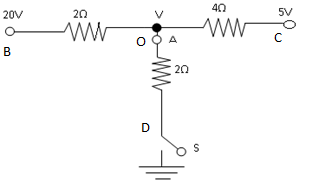Question
Question: A switch S is closed in the circuit shown in figure, current passed through point A is? 
A. 4.5A
B. 6.0A
C. 3.0A
D. Zero
Solution
We are given to find the value of current through point A. The resistance values of all branches are given, to find the current we need to first find the value of voltage. Use Kirchhoff’s junction rule to find the value of voltage V and then calculate the value of current passing through point A.
Complete step by step answer:
To find the current at point A, we will use Kirchhoff’s junction rule.
According to Kirchhoff’s junction rule, the sum of all the currents entering and leaving a node in a circuit is always equal to zero.
Let us name the branches for simplicity

Now, we find the current through each branch
Current through branch BO is IBO=RBOVBO where VBO is voltage drop across BO which is VBO=V−20 and RBO is resistance on BO branch which is given as 2Ω. Therefore, current through BO is IBO=RBOVBO=2V−20.
Current through branch CO is ICO=RCOVCO where VCO is voltage drop across CO which is VCO=V−5 and RCO is resistance on CO branch which is given as 4Ω. Therefore, current through CO is ICO=RCOVCO=4V−5.
Current through branch CO is IDO=RDOVDO where VDO is voltage drop across DO which is VDO=V−0 and RDO is resistance on DO branch which is given as 2Ω. Therefore, current through DO is IDO=RDOVDO=2V−0=2V.
Now, applying Kirchhoff’s junction rule at point O we get
IBO+ICO+IDO=0 (i)
Putting the values of IBO, ICO and IDO in equation (i), we get
